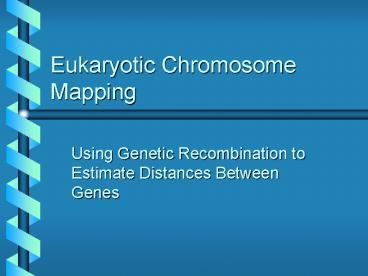Eukaryotic Chromosome Mapping - PowerPoint PPT Presentation
1 / 32
Title:
Eukaryotic Chromosome Mapping
Description:
Beige body Ebony body. RRBB rrbb. F1: Red eyes, Beige body. RrBb. Independent Assortment ... Ebony body. 250. 398. Red eyes. Beige body. Expected for Unlinked ... – PowerPoint PPT presentation
Number of Views:2133
Avg rating:3.0/5.0
Title: Eukaryotic Chromosome Mapping
1
Eukaryotic Chromosome Mapping
- Using Genetic Recombination to Estimate Distances
Between Genes
2
Linked Genes
3
Independent Assortment vs. Gene Linkage
- Example from Drosophila
- Red eyes, x Pink eyes
- Beige body Ebony body
- RRBB rrbb
4
Independent Assortment vs. Gene Linkage
- Testcross cross to individual of
known genotype - F1Red eyes X Pink eyes
- Beige body Ebony body
- RrBb rrbb
5
Independent Assortment vs. Gene Linkage
6
Independent Assortment vs. Gene Linkage
- F1Red eyes X Pink eyes
- Beige body Ebony body
- RrBb rrbb
RB
Rb
rb
rB
rb
7
Independent Assortment vs. Gene Linkage
If genes are linked Red eyes, x
Pink eyes Beige body Ebony body
Coupling or Cis Configuration
8
Independent Assortment vs. Gene Linkage
- F1 Red eyes, Beige body
Four types of gametes are produced
Parental Recombinant
9
Independent Assortment vs. Gene Linkage
- F1Red eyes X Pink eyes
- Beige body Ebony body
- R B r b
- r b r b
r B
R B
r b
R b
r b
r b
r b
r b
r b
10
Independent Assortment vs. Gene Linkage
11
Genetic Map Units
- 1 recombination 1 map unit 1
centimorgan - 108 112 x 100 22
- 1000
- These genes are located 22 map units apart on
the same chromosome.
12
Limits of Genetic Mapping
- Genes that are 50 map units apart will appear
to assort independently.
13
Predicting Gamete Frequencies for Linked Genes
Red eyes, x Pink eyes Ebony body
Beige body
Repulsion or Trans Configuration
14
Predicting Gamete Frequencies for Linked Genes
- The genes are 22 map units apart, therefore we
expect 22 recombinant gametes and 78 parental
gametes.
0.22 recombinants
0.78 parentals
15
Using a Three-point Testcross to Determine
Genetic Distance
- A cross between two parental strains is used to
produce a tri-hybrid (heterozygous for three
genes). - The tri-hybrid is crossed to an organism that is
homozygous recessive for all three genes. - Eight classes of offspring are analyzed to
determine recombination frequencies.
16
Problem 1, Page 2-1
17
Problem 1, Page 2-1 With Arbitrary Gene Order
18
Problem 1, Page 2-1With Arbitrary Gene Order
19
Problem 1, Page 2-1
Offspring Resulting from Three-Point Testcross
20
Problem 1, Page 2-1
- Determine which classes are parentals
- Determine which classes are double
recombinants - Determine the gene order
- Assign genotypes to all classes
- Calculate recombination frequencies
21
Problem 1, Page 2-1
- Determine which classes are parentals
- The two parental classes will represent
- the largest number of offspring in the
- F2 generation.
- Information on the parents may be
- given in the problem description itself.
Parentals red, tall, ragged
green, dwarf, normal
22
Problem 1, Page 2-1
- Determine which classes are double
- recombinants
- Double recombinants have two
- crossovers one between the first and
- middle gene and one between the middle
- and third gene
- These will be the two smallest classes.
Double Recombinants red, tall, normal
green, dwarf, ragged
23
Problem 1, Page 2-1
- Determine the gene order
- The middle gene is the one that changes
- places in the double recombinants when
- compared to the parental combinations.
24
Problem 1, Page 2-1
This shows why other gene orders are incorrect.
A d Rg
A D Rg
Red, dwarf, ragged
X
X
a d rg
a D rg
Green, tall, normal
D a Rg
D A Rg
Green, tall, ragged
X
X
d A rg
d a rg
Red, dwarf, normal
25
Problem 1, Page 2-1
- Assign genotypes to all classes
- Use correct gene order
P
A Rg D/a rg d
a rg d/a rg d
P
A rg D/a rg d
DC
a Rg d/a rg d
DC
A? Rg
A rg d/a rg d
A? Rg
a Rg D/a rg d
Rg? D
A Rg d/a rg d
Rg? D
a rg D/a rg d
26
Problem 1, Page 2-1
Recombination between A and Rg
27
Problem 1, Page 2-1
Recombination between A and Rg
A rg d 90
Single Crossovers
a Rg D 70
Double Crossovers
A rg D 24
a Rg d 16
Total 200
recombination (200/1000) x 100 20
28
Problem 1, Page 2-1
Recombination between Rg and D
29
Problem 1, Page 2-1
Recombination between Rg and D
A Rg d 120
Single Crossovers
a rg D 140
Double Crossovers
A rg D 24
a Rg d 16
Total 300
recombination (300/1000) x 100 30
30
Problem 1, Page 2-1
Two maps are possible
A Rg
D 20 map units 30 map units
or
D Rg
A 30 map units 20
map units
31
Interference
- Interference crossover in one region inhibits
crossover in an adjacent region - Interference 1 (coefficient of coincidence)
- Coefficient of coincidence
- Observed double crossovers
- Expected double crossovers
32
Calculating Interference
- Coefficient of coincidence
- Observed double crossovers
- Expected double crossovers
- 24 16 40 0.667
- 0.2 x 0.3 x 1000 60
- Interference
- 1(coefficient of coincidence)
- 1- 0.667 0.333































